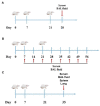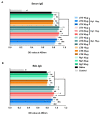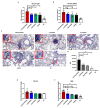Escherichia coli Heat-Labile Enterotoxin B Subunit Combined with Ginsenoside Rg1 as an Intranasal Adjuvant Triggers Type I Interferon Signaling Pathway and Enhances Adaptive Immune Responses to an Inactivated PRRSV Vaccine in ICR Mice
- PMID: 33809809
- PMCID: PMC8002527
- DOI: 10.3390/vaccines9030266
Escherichia coli Heat-Labile Enterotoxin B Subunit Combined with Ginsenoside Rg1 as an Intranasal Adjuvant Triggers Type I Interferon Signaling Pathway and Enhances Adaptive Immune Responses to an Inactivated PRRSV Vaccine in ICR Mice
Abstract
Porcine reproductive and respiratory syndrome virus (PRRSV) is a major pathogen that has threatened the global swine industry for almost 30 years. Because current vaccines do not provide complete protection, exploration of new preventive strategies is urgently needed. Here, we combined a heat-labile enterotoxin B subunit of Escherichia coli (LTB) and ginsenoside Rg1 to form an intranasal adjuvant and evaluated its enhancement of immune responses in mice when added to an inactivated-PRRSV vaccine. The combination adjuvant synergistically elicited higher neutralizing and non-neutralizing (immunoglobulin G and A) antibody responses in the circulatory system and respiratory tract, and enhanced T and B lymphocyte proliferation, CD4+ T-cell priming, and cytotoxic CD4+ T cell activities in mononuclear cells from spleen and lung tissues when compared to the PRRSV vaccine alone, and it resulted in balanced Th1/Th2/Th17 responses. More importantly, we observed that the combination adjuvant also up-regulated type I interferon signaling, which may contribute to improvement in adaptive immune responses. These results highlight the potential value of a combined adjuvant approach for improving the efficacy of vaccination against PRRSV. Further study is required to evaluate the efficacy of this combined adjuvant in swine.
Keywords: LTB; PRRSV; Rg1; intranasal adjuvant; type I interferon.
Conflict of interest statement
The authors declare no conflict of interest.
Figures









Similar articles
-
Escherichia coli heat-labile enterotoxin B subunit as an adjuvant of mucosal immune combined with GCRV-II VP6 triggers innate immunity and enhances adaptive immune responses following oral vaccination of grass carp (Ctenopharyngodon idella).Fish Shellfish Immunol. 2024 Nov;154:109969. doi: 10.1016/j.fsi.2024.109969. Epub 2024 Oct 16. Fish Shellfish Immunol. 2024. PMID: 39419132
-
Potentiation of Taishan Pinus massoniana pollen polysaccharide on the immune response and protection elicited by a highly pathogenic porcine reproductive and respiratory syndrome virus glycoprotein 5 subunit in pigs.Mol Cell Probes. 2016 Apr;30(2):83-92. doi: 10.1016/j.mcp.2016.01.008. Epub 2016 Jan 30. Mol Cell Probes. 2016. PMID: 26828953
-
Synthetic B- and T-cell epitope peptides of porcine reproductive and respiratory syndrome virus with Gp96 as adjuvant induced humoral and cell-mediated immunity.Vaccine. 2013 Apr 3;31(14):1838-47. doi: 10.1016/j.vaccine.2013.01.049. Epub 2013 Feb 7. Vaccine. 2013. PMID: 23395588
-
Innate and adaptive immunity against Porcine Reproductive and Respiratory Syndrome Virus.Vet Immunol Immunopathol. 2015 Sep 15;167(1-2):1-14. doi: 10.1016/j.vetimm.2015.07.003. Epub 2015 Jul 17. Vet Immunol Immunopathol. 2015. PMID: 26209116 Free PMC article. Review.
-
Inactivated and subunit vaccines against porcine reproductive and respiratory syndrome: Current status and future direction.Vaccine. 2015 Jun 17;33(27):3065-72. doi: 10.1016/j.vaccine.2015.04.102. Epub 2015 May 14. Vaccine. 2015. PMID: 25980425 Review.
Cited by
-
Incorporation of Escherichia coli heat-labile enterotoxin B subunit into rabies virus particles enhances its immunogenicity in mice and dogs.Biosaf Health. 2023 May 9;5(5):308-319. doi: 10.1016/j.bsheal.2023.05.005. eCollection 2023 Oct. Biosaf Health. 2023. PMID: 40078911 Free PMC article.
-
Ginsenosides are active ingredients in Panax ginseng with immunomodulatory properties from cellular to organismal levels.J Ginseng Res. 2022 Nov;46(6):711-721. doi: 10.1016/j.jgr.2021.12.007. Epub 2021 Dec 22. J Ginseng Res. 2022. PMID: 36312737 Free PMC article. Review.
-
Intranasal delivery of inactivated PRRSV loaded cationic nanoparticles coupled with enterotoxin subunit B induces PRRSV-specific immune responses in pigs.Sci Rep. 2022 Mar 8;12(1):3725. doi: 10.1038/s41598-022-07680-9. Sci Rep. 2022. PMID: 35260663 Free PMC article.
-
Safety and Efficacy of the Bordetella bronchiseptica Vaccine Combined with a Vegetable Oil Adjuvant and Multi-Omics Analysis of Its Potential Role in the Protective Response of Rabbits.Pharmaceutics. 2022 Jul 8;14(7):1434. doi: 10.3390/pharmaceutics14071434. Pharmaceutics. 2022. PMID: 35890330 Free PMC article.
-
Immune Enhancement of Nanoparticle-Encapsulated Ginseng Stem-Leaf Saponins on Porcine Epidemic Diarrhea Virus Vaccine in Mice.Vaccines (Basel). 2022 Oct 27;10(11):1810. doi: 10.3390/vaccines10111810. Vaccines (Basel). 2022. PMID: 36366319 Free PMC article.
References
-
- Linhares D.C., Cano J.P., Wetzell T., Nerem J., Torremorell M., Dee S.A. Effect of modified-live porcine reproductive and respiratory syndrome virus (PRRSv) vaccine on the shedding of wild-type virus from an infected population of growing pigs. Vaccine. 2012;30:407–413. doi: 10.1016/j.vaccine.2011.10.075. - DOI - PubMed
Grants and funding
LinkOut - more resources
Full Text Sources
Other Literature Sources
Research Materials

